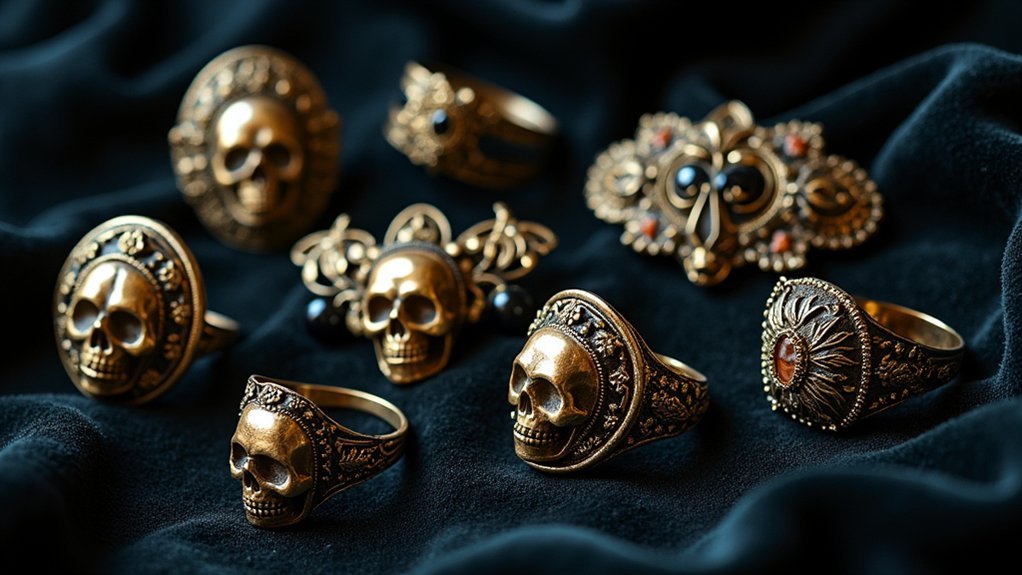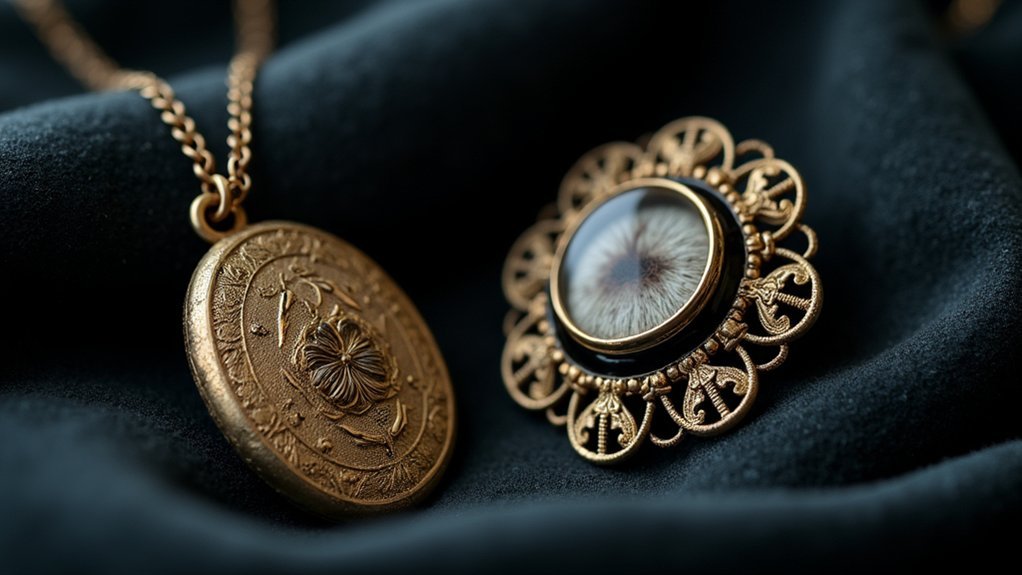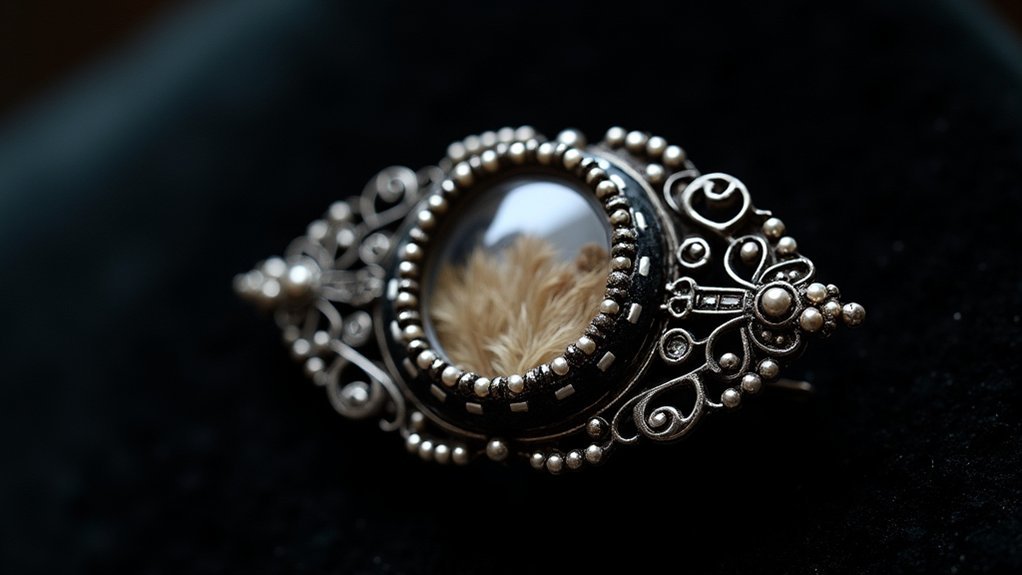Victorians wore death-related jewelry primarily as visible symbols of grief following Queen Victoria’s 40-year mourning period after Prince Albert’s death in 1861. You’d find these pieces served dual purposes—they honored the deceased through materials like jet or human hair while signaling to society your mourning stage. Strict protocols dictated when you could wear specific pieces, with intricate symbolism (skulls, urns, willows) communicating messages about mortality. These wearable memorials reveal much about Victorian attitudes toward death and remembrance.
The Cult of Mourning: Queen Victoria’s Profound Influence

When Prince Albert died unexpectedly in 1861, Queen Victoria’s overwhelming grief transformed not only her personal life but also the cultural landscape of an entire era. Her decision to wear black for the remaining forty years of her life established mourning practices that society quickly adopted.
As sovereign, Victoria’s influence extended beyond the palace walls. She required court members to don black attire and mourning jewelry for lengthy periods, a practice that rippled throughout British society.
This structured approach to grief—where you’d wear specific items for designated mourning phases—became known as the “Cult of Mourning.”
The Victorian era saw unprecedented popularity in mourning jewelry made from jet, onyx, and even the deceased’s hair.
You couldn’t participate in proper society without adhering to these customs, which remained dominant until about 1880.
Materials and Craftsmanship: From Jet to Hair Art
While Queen Victoria set the cultural tone for mourning practices, it was the remarkable artisans and their chosen materials that transformed grief into wearable art.
The alchemy of Victorian mourning transformed profound loss into exquisite wearable memorials through masterful craftsmanship.
Victorian mourning jewelry showcased exceptional craftsmanship using materials that symbolized both loss and remembrance.
You might encounter these fascinating elements in authentic Victorian memorial pieces:
- Jet – A lustrous black lignite requiring skilled hands to carve intricate designs, making it the premier choice for high-quality mourning jewelry.
- Black glass – A more affordable alternative that democratized mourning customs while mimicking jet’s appearance.
- Human hair – Woven into elaborate patterns, creating personal keepsakes that literally contained a piece of the deceased.
- Documented techniques – Craftspeople followed detailed instructions from published guides, ensuring even amateur artisans could create meaningful tributes.
Symbolism and Sentimentality in Victorian Death Jewelry

Victorian mourning jewelry speaks directly to you through its rich symbolism, with memento mori motifs like skulls and urns reminding you of life’s brevity while offering comfort in loss.
You’ll find these personal keepsakes often contained intricate hair art, where loved ones’ locks were woven into elaborate designs or encased behind glass, creating lasting connections to the deceased.
These intimate tokens weren’t merely decorative but served as physical links between the living and dead, allowing you to carry memories close to your heart during the prescribed mourning period.
Memento Mori Motifs
Though modern sensibilities might consider death-themed jewelry macabre, the Victorians embraced memento mori motifs as profound expressions of love and remembrance.
Queen Victoria’s extended mourning for Prince Albert popularized Victorian mourning jewelry, making these symbols socially acceptable and even fashionable alongside black clothing.
Memento mori jewelry included various symbolic elements that reminded wearers of mortality:
- Skulls – explicit reminders of death’s inevitability
- Urns – representing the departed soul and eternal rest
- Weeping willows – symbolizing grief and the natural cycle of life
- Hair lockets – containing actual remnants of the deceased
When you wore a mourning ring or other memorial piece, you weren’t simply accessorizing—you were participating in a cultural practice that acknowledged death’s certainty while preserving connections to loved ones.
Hair Art Keepsakes
Among the most intimate forms of Victorian mourning jewelry, hair art keepsakes represented the pinnacle of personal memorial craftsmanship.
You’d find these deeply sentimental pieces worn prominently as brooches, rings, and other ornaments throughout the Victorian era.
When you lost a loved one, you’d collect locks of their hair—a material considered immortal—to be woven into intricate designs or displayed in specially designed settings.
Women often created these hair jewelry pieces themselves, demonstrating both their artistry and commitment to remembrance customs.
Social Protocols and Mourning Etiquette
In Victorian society, you’d need to observe rigid mourning stages that governed both your attire and jewelry choices for specific timeframes following a loved one’s death.
Your social class directly influenced how elaborately you could display your grief, with wealthy women often commissioning custom mourning pieces while working-class families might only afford a simple jet brooch or hair memento.
These class distinctions in mourning jewelry weren’t just expressions of wealth but served as visual signals of one’s adherence to proper Victorian grief etiquette, reinforcing social hierarchies even in times of personal loss.
Strict Mourning Stages
When death visited a Victorian household, survivors entered a rigidly structured world of mourning governed by complex social expectations.
Queen Victoria’s extended grief for Prince Albert transformed mourning into a rigid social institution, as she wore black for the remainder of her life.
The Victorian mourning customs established precise timelines for grief expression:
- Full mourning – One year in all black attire, with jet or onyx mourning jewelry being the only acceptable adornments
- Second mourning – Nine months allowing some trimmings and less severe black fabrics
- Half-mourning – Three to six months incorporating gray, lavender, and mauve
- Gradual return – Slow reintroduction to society and normal dress
Your mourning jewelry served dual purposes—expressing personal grief while publicly signaling your adherence to these strict protocols.
Class-Based Grief Display
The visual language of Victorian mourning operated as a strict social barometer, allowing observers to immediately assess both your grief and your financial standing. Your mourning jewelry immediately signaled your social class through its materials and craftsmanship. Wealthier individuals commissioned bespoke pieces with intricate designs and personalized inscriptions, while those of modest means relied on mass-produced alternatives.
The strict mourning protocols emphasized class distinctions in grief display. If you belonged to the upper class, you’d adhere to elaborate mourning rituals, evolving through full to half-mourning with appropriate accessories at each stage.
The quality of your jet or onyx pieces, the complexity of their design, and your ability to maintain a complete mourning wardrobe for the prescribed period all reinforced your position in society while expressing your loss.
The Art of Remembrance: Photography and Keepsakes

Victorian mourners embraced photography as a revolutionary tool to preserve the likenesses of their departed loved ones, creating permanent visual memories otherwise impossible before this technological advancement.
During the Victorian era, these photographic keepsakes became integral to mourning practices, often incorporated into jewelry worn close to the heart.
You’ll find these remembrance traditions expressed through:
- Post-mortem portraits where deceased family members were posed as if still alive
- Lockets containing miniature photographs worn as pendants or brooches
- Mourning jewelry incorporating both photographs and locks of hair
- Ornate frames displaying death portraits in home memorial spaces
These tangible connections to the deceased weren’t merely decorative—they served as physical reminders that helped you process grief while keeping your loved one’s memory present in daily life.
Ancient Origins and Evolution of Memento Mori Jewelry
Ancient civilizations first embraced the concept of memento mori jewelry, establishing practices that would later inspire Victorian mourning traditions. From Egyptian funerary items to Roman mourning rings inscribed with personal messages, these early commemorative items reflected humanity’s enduring need to remember those who’d passed.
During the Middle Ages, this tradition evolved to include stark reminders of mortality through skull and crossbone motifs, emphasizing life’s impermanence.
The Renaissance period brought neoclassical elements like decorative urns, symbolizing the soul’s journey beyond death.
Frequently Asked Questions
What Does Mourning Jewelry Symbolize in the Victorian Era?
Mourning jewelry symbolizes your deep grief and remembrance of lost loved ones. You’ll find it displays sorrow through willows and urns, using materials like jet and hair to maintain connections with the deceased.
What Is the Victorian Symbol of Death?
In Victorian symbolism, you’ll find death represented by skulls, crossed bones, and weeping willows. You’re also seeing urns, cherubs, and black jet jewelry prominently featured in mourning customs and memorial pieces.
What Did Victorian Jewelry Symbolize?
Victorian jewelry symbolized your grief, remembrance, and social status. You’d wear pieces made of jet or onyx, adorned with weeping willows or cherubs, often containing locks of hair from deceased loved ones.
When Was Mourning Jewelry Popular?
You’ll find that mourning jewelry was most popular during the Victorian era, particularly from the 1860s to 1880s, following Queen Victoria’s intense grief after Prince Albert’s death in 1861.
In Summary
You’ve discovered that Victorian death jewelry wasn’t merely fashionable but deeply meaningful in a society grappling with mortality. From Queen Victoria’s influence to intricate hair art, these pieces allowed you to honor loved ones while maneuvering through strict mourning protocols. Today’s remembrance customs may differ, but you’re witnessing the same human need to maintain connections with those you’ve lost—a timeless impulse stretching back to ancient memento mori traditions.





Leave a Reply